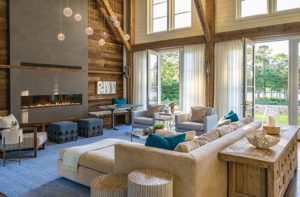M. Benjamin Herndon: Fade to Black
September 24, 2019
Text by William Morgan
When M. Benjamin Herndon exhibits his stunning darker-than-black paintings, he gives them non-emotive names, like Field No. 2 or Adjacent No. 3. But a large canvas like Lift is anything but basic or anonymous. Even though it seems monochromatic at first glance, the work is complex, made up of a dozen layers of a unique graphite paint that Herndon makes from scratch. He polishes his painting surfaces and draws on them with silverpoint to create organically geometric patterns in black tones that range from silvery to charcoal. Time spent with Lift reveals the subtlety of the layers, a tactile sense of the paint, and a sense of movement. As the thirty-four-year-old artist notes, the work is “more about light than darkness.”
These explorations by the Rhode Island School of Design-trained printmaker are more than minimalism, although he purposely restricts his palette as a way of reducing distractions. Such quietude “calls attention to everything,” he says. Herndon’s art is subtle, meditative, and quite Eastern. Compositions like Lift demand much of the artist, but also, they require engagement of the viewer. There is no place to hide, as the creator’s very soul is on display.
Herndon’s recent work is part of a journey of exploration. His “aha moment” occurred when he saw how carbon reacted to paper. Graphite, or crystallized carbon, sent him in a new direction. Carbon printing is an obsolete, time-consuming, and singularly focused process. If that weren’t demanding enough, he also works with lead. As part of his master’s thesis at RISD, Herndon, who studied papermaking in Japan, printed images of Japanese handmade paper on a fifty-pound, twenty-five-foot-long roll of lead sheeting from Home Depot. He then crafted a cherrywood presentation box to hold the scroll.
A project like the boxed lead seems so utterly self-effacing, like Zen in its denial of the usual artistic ego. Such a cerebral approach would seem a tough path for a full-time artist. Yet Herndon’s hesitancy to compromise has earned serious respect. He has exhibited in New York, Boston, Tokyo, and Beijing. That he is represented by Inde/Jacobs Gallery in the internationally famous contemporary art mecca of Marfa, Texas, is further affirmation of the quality of his work.
The artist made a deliberate choice to live and work in Providence. “My work would not be where it is now were I not in Providence,” he says. His studio in the Atlantic Delaine Mills in the city’s Olneyville neighborhood is 1,400 square feet and has ceilings that soar as high as twenty-five feet. He readily admits he couldn’t afford such a large workspace had he stayed in New York City. The Civil War-era woolen mill provides the ideal space for a painter/printmaker who works in large scale and with industrial materials. He has room for a wood shop, and eventually will add a printing press.
Hayward and his wife, Juli Anna Herndon, a poet, are both from rural California. After spending time in Portland, Oregon, studying math and philosophy, he moved to New York to go to the School of Visual Arts, while Juli Anna went to Sarah Lawrence College. They moved to Providence when Benjamin enrolled at RISD to pursue an MFA in printmaking.
“Moving to a small city was good for me,” Herndon says. While one might expect a young artist to feel like he should be in New York City, he prefers Providence’s less frenetic pace, and enjoys being able to commute from his home to his studio by bicycle. He has taught lithography at RISD and, in the last three years, has held residencies at such prestigious art colonies as the Tamarind Institute, the Josef & Anni Albers Foundation, and the Vermont Studio Center.
Herndon confesses he came late to art. “I made my first painting when I was twenty-three,” he says. Now, little more than a decade later, he welcomes the challenge of working with unconventional materials. Despite the strength of his black graphite paintings, Herndon says he is not anti-color, and doubts that he will explore the light-in-the-dark theme forever.
But for now, the meticulous nature of his work, where the content is the material, provides real satisfaction. His craft requires a lot of solitude, but Herndon is reaping the rewards of his determination to follow his cerebral exploration of exploration of the depths of black.
EDITOR’S NOTE: M. Benjamin Herndon is represented in New England by A R E A Gallery, Boston, area.gallery. To see more of his work, visit mbenjaminherndon.com.
Share
![NEH-Logo_Black[1] NEH-Logo_Black[1]](https://www.nehomemag.com/wp-content/uploads/2022/08/NEH-Logo_Black1-300x162.jpg)
















You must be logged in to post a comment.